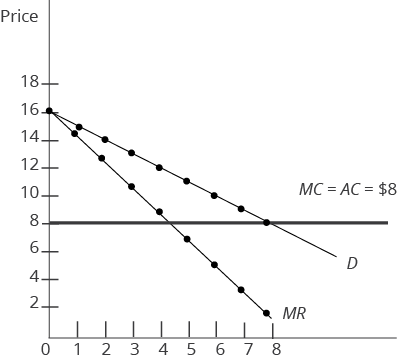Monopoly
Purpose
In this chapter, you have learned the characteristics of monopolies and about barriers that protect monopoly profits by preventing entry of other firms into monopoly markets. You have also learned how a monopoly is inefficient compared to perfect competition.
The purposes of this exercise are to determine if markets that you encounter on a regular basis are monopolies and to identify barriers to entry in those monopoly-based markets to compare monopoly outcomes with those of perfect competition.
Directions
This exercise has two parts. In the first, you'll determine whether some familiar goods and services are monopolies and identify their barriers to entry. In the second, you will contrast the equilibrium price and quantity for a monopoly with that of perfect competition.
Part 1 - Monopolies and Barriers to Entry
Create a table, listing the following goods and services in the first column: electricity, campus bookstore, a required textbook, TikTok, cell phones, and a brand-name drug. Then, in the second column, indicate whether each good or service is likely produced in a monopoly market and whether or not you think this market is a monopoly. If it is, identify the barrier(s) to entry in the third column. Then, list some other goods or services that you frequently purchase and provide the same information.
Part 2 - Comparing Monopoly and Perfect Competition
Assume that the following graph represents the demand, marginal revenue, average total cost, and marginal cost for a small business that has been granted a monopoly to provide lunches for visitors to a state park. Additionally, assume that the average and marginal cost of each lunch is .

The x-axis is unlabeled, and the y-axis is labeled "Price." There are three lines. The first is a horizontal line at on the y-axis. It is labeled MC = AC = . The second line is labeled D. It has the following points: , , , , , , , , and where is crosses with the horizontal line, . The third line is labeled MR. It has the following points: , , , , , , , , and .
Answer the following questions:
-
To maximize profit, the monopoly will produce (blank) lunches and charge (blank) per lunch.
-
How did you determine the monopoly's equilibrium price and quantity?
-
If the firm loses its monopoly and many other firms are allowed to enter the market so that the market becomes perfectly competitive, the output will be (blank) lunches, and the price will be per lunch.
-
Compared to perfect competition, the output for a monopoly will be (blank) (less, more), and the monopoly price will be (blank) (higher, lower) than the price in perfect competition.
-
Explain how you determined the perfectly competitive firm's price and output.
-
Compare monopoly and perfect competition with respect to productive and allocative efficiency.